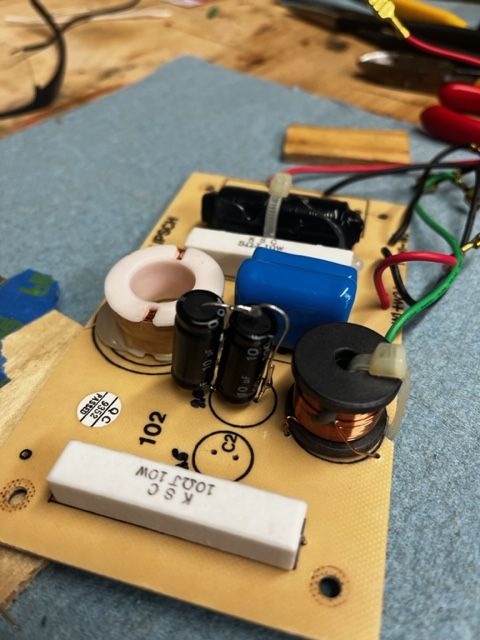-
Posts
71 -
Joined
-
Last visited
Content Type
Forums
Events
Gallery
Everything posted by Jhakobe
-
After rereading many of your comments and reviewing other similar topics here and other places, I’m attempting to parallel two caps to get the required rating. I’ve attached two 10uf to equal the 20uf of the original (in photo). The other required rating is 25uf and I plan to use a 10uf and a 15uf. Any comments, advice, critique appreciated. Thanks again everyone. This has turned into quite the learning experience.
-
Until last evening I didn’t have a diagram. I finally made one (probably should’ve started with this) and you are correct - the caps I’m replacing are both parallel. As mentioned, I would have preferred to use electrolytics and agree they are sufficient for this application, but I couldn’t find the correct values and tolerances. The Dayton polypropylene caps match exact but are comically large. What do you think about values/tolerances being exact when they are wired parallel - is it less important than if they were in series? Is there a capacitance range and tolerance which would be acceptable?
-
Typical manufacturer claimed tolerances seem to be 20%; +50%, -10% (and similar broad, non-equal ranges); and 10%.
-
Much appreciated suggestion. I saw those and considered using…I opted against them due to the 20% tolerance. The original cap tested outside of its 10% tolerance prompting replacement. The 24uf with 20% tolerance puts their range outside of the original spec. That said, if the conventional wisdom here is that this is an acceptable range and I’ve made an error in emphasis on the tolerance spec, I’d certainly consider using the 24uf cap or putting back the original caps (which I think are testing around 12% of their stated value).
-
Support for their environment is concerning to me as well. Given the space inside the cabinet and on the board, this seemed like my best option, short of running longer extensions to remotely positioned caps. The caps feel secure in their position presently. Do you think I should try another option or give it a go and repair if it fails? I’m not operating under the assumption that Mylar caps are a degrading component in a crossover network unless they show physical signs of damage or cap replacement isn’t successful in restoring sound quality. Flawed thinking?
-
There’s a lot on here and other audio forums discussing the use of equal value but different construction capacitors and I’ve tried to read through what I could. And while I would not claim to understand all of what was read, it seemed most appropriate for me to try and replace the NPEs with NPEs. Not being able to find them, locating something with a tight tolerance and the same value was the next logical step (TBD if that was the correct move). Ideally the goal is to restore the speakers to their original sound (not some “upgrade”). That goal is quickly changing to be a restoration that gets as close as reasonably possible.
-
25uf and 20uf, 10% tolerance.
-
Yeah, not real happy about the size. They are the only ones I could find that had the same tolerance and capacitance as the originals. I’d of happily found and used NPEs if available. Maybe I should reach out to JEM and see if they have any if this is not a good idea.
-
Thanks! Obviously I need to figure out how to get the video link to post properly. 🤔
-
After several trial fittings, this is what I ended up with due to the cap sizes being massively(!) larger than the original NPEs. The cap lead extension wire is solid 18ga copper connected with the j-hook method. Caps are held with small piece of double-sided tape (good to 250f) between the caps and a zip tie. Weight is supported by the inner-most cap and the soldered leads themselves. Thoughts on this before I tear into the other speaker?
-
I usually save an unopened album to enjoy on the solstice, along with a big beer or a special bourbon. Last night was Khruangbin’s Mordechai (and a nice imperial stout). Cheers to longer days…after we endure the freezing cold and some of us dig out from snow drifts. https://youtu.be/wPn-iV7ds0I
-
I’m finding all of this extremely helpful. Glad the topic has expanded.
-
I checked out JEM but it looked like they mostly provide capacitor kits. It’s worth contacting them, though. Thanks. If they don’t have anything it looks like I have a plan “B”.
-
Great information. Thank you!
-
That perfectly shows me what I need to do. Thank you! For the lead extension wire, is that something I can order as well, does it have a name?
-
Good to know they’re hard to find and that it’s not just me. If you have time, and don’t mind posting a picture, I would appreciate knowing how pros do it. Thanks.
-
I’ve searched through the forum and not found a satisfying answer, so I’m just going to ask what may be a silly question: Can I use an axial capacitor in place of a radial and, more importantly (or more confounding to me), how can the axial be mounted sufficiently? This question is in regards to a pair of KG 1.5 speakers I recently acquired. The sound was off between them so I opened them up to find one blown woofer. While the crossover was out I desoldered a 25uf cap and checked it - it read 28.5, so out of spec. Klipsch still has the woofers (yay!) so I ordered them. I’m having trouble finding a decent radial 25uf capacitor (and a 20uf) to replace the old ones. Axial’s are available though. Any insight greatly appreciated!





